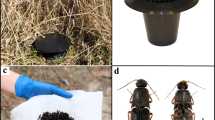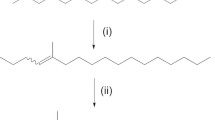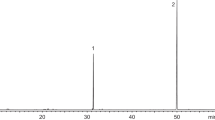Abstract
A newly developed bioluminescent assay was used to measure quantitatively the amount of (E)-11-tetradecenal, the major component of the sex pheromone of the spruce budworm, trapped on Porapak Q®. The bioluminescent response was linearly related to the amount of aldehyde either deposited on the absorbent or trapped from an airstream. However, the recovery of pheromone from Porapak was dependent on whether the air was prefiltered (through Porapak) or taken directly from the atmosphere. Furthermore, pheromone on Porapak was lost with time during the flow of air through the absorbent, indicating that trapping of aldehyde pheromone should be conducted for short periods of time for optimal recoveries. The applicability of the assay system for the rapid and direct measurement of the release rates of aldehyde pheromone lures was demonstrated for pheromone lures used for baiting spruce budworm traps.
Similar content being viewed by others
References
Baker, T.C., Cardé, R.T., andMiller, J.R. 1980. Oriental fruit moth pheromone component emission rates measured after collection by glass-surface adsorption.J. Chem. Ecol. 6:749–758.
Browne, L., Birch, M.C., andWood, D.L. 1974. Novel trapping and delivery system for air-borne insect pheromones.J. Insect. Physiol. 20:183–193.
Byrne, K.J., Gore, W.E., Pearce, G.T., andSilverstein, R.M. 1975. Porapak Q collection of airborne organic compounds serving as models for insect pheromones.J. Chem, Ecol. 1:1–7.
Caro, J.H., Glotfelty, D.E., andFreeman, H.P. 1980. (Z)-9-Tetradecen-1-ol formate. Distribution and dissipation in the air within a corn crop after emission from a controlled-release formulation.J. Chem. Ecol. 6:229–239.
Cross, J.H., Tumlinson, J.H., Health, R.E., andBurnett, D.E. 1980. Apparatus and procedure for measuring release rates from formulations of leptidopteran semiochemicals.J. Chem. Ecol. 6:759–770.
Grant, G.G., Slessor, K.N., Szittnbr, R.B., Morse, D., andMeighen, E.A. 1982. Development of a bioluminescence assay for aldehyde pheromones of insects. II. Analysis of pheromone glands.J. Chem. Ecol. 8:923–933.
Gunsulas-Miguel, A., Meighen, E., Ziegler Nicoli, M., Nealson, K.H., andHastings, J.W. 1972. Purification and properties of bacterial luciferases.J. Biol. Chem. 247:398–404.
Meighen, E.A., Slessor, K.N.,andGrant, G.G. 1982. Development of a bioluminescence assay for aldehyde pheromones of insects. I. Sensitivity and specificity.J. Chem. Ecol. 8:911–921.
Sanders, C.J. 1981. Release rates and attraction of PVC lures containing synthetic sex attractant of the spruce budworm,Choristoneura fumiferana (Lepidoptera: Tortricidae).Can. Entomol. 113:103–111.
Sanders, C.J., andWeatherston, I. 1976. Sex pheromone of the eastern spruce budworm (Lepidoptera: Tortricide): Optimum blend oftrans- andcis11-tetradecenal.Can. Entomol. 108:1285–1290.
Shapas, T.J., andBurkholder, W.E. 1978. Patterns of sex pheromone release from adult females and effects of air velocity and pheromone release rates on theoretical communication distances inTrogoderma glabrum.J. Chem. Ecol. 4:395–408.
Silk, P.J., Tan, S.K., Wiesner, C.J., Ross, R.J., andLonergan, G.C., 1980. Sex pheromone chemistry of the eastern spruce budworm,Choristoneura fumiferana.Environ. Entomol. 9:640–644.
Weatherston, J., Golub, M.A., Brooks, T.W., Huang, Y.Y., andBenn, M.H., 1981. Methodology for determining the release rates of pheromones from hollow fibers,in E.R. Mitchel (ed.). Management of Insect Pests with Semiochemicals. Plenum, New York, pp. 425–443.
Wiesner, C.J., Silk P.J., Tan, S.H., andFullarton, S. 1980. Monitoring of atmospheric concentrations of the sex pheromone of the spruce budworm,Choristoneura fumiferana (Lepidoptera: Tortricidae)Can. Entomol. 112:333–334.
Author information
Authors and Affiliations
Additional information
This investigation was supported by the U.S.D.A. Forest Service Program entitled Canada United States Spruce Budworms Program (23–345) and the Medical Research Council of Canada (MT-4314).
Rights and permissions
About this article
Cite this article
Szittner, R.B., Morse, D., Grant, G.G. et al. Development of a bioluminescence assay for aldehyde pheromones of insects. J Chem Ecol 8, 935–945 (1982). https://doi.org/10.1007/BF00987660
Received:
Revised:
Issue Date:
DOI: https://doi.org/10.1007/BF00987660




